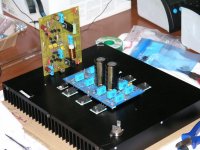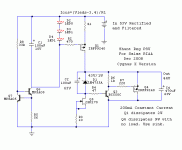I think it would be good at this point to recall where things are coming from and thus give credit where credit is due. Can anyone recognize this topology?


If you don't, then you haven't looked carefully at salas' regulator. This design is due to Are Waagbo, who published an article named "Shunt or Not" in the Feb 2008 issue of AudioXpress (US print magazine) pp. 30-37. Here's a link to the actual article, which is a very good read:
http://www.borbelyaudio.com/pics/waagbo2863.pdf
Notice the article is hosted by Erno Borbely's website. This is no coincidence, as Mr. Waagbo and Mr. Borbely are friends. In fact Mr Borbely says this in an interview:
"My friend Are Waagbo used a combination of a series current-source feeding into a parallel shunt, and that is probably the very best you can do for regulated supplies. ... What I find quite important in supplies is to use reservoir caps with the lowest ESR practicable, and use lots of it. I believe in very stiff raw supplies. That makes sure that the raw voltage going into the regulator is as smooth as possible. And, by the way, Walt and you have also done a lot of good work on regulators!" The interviewer being Jan Didden, the last sentence refers to him. In fact I regret that Jan Didden has not chipped in at all in this thread; his experience with regulators is immense and I'm sure he could have contributed some awesome advice. Anyway, the entire interview can be found here:
]http://www.borbelyaudio.com/pics/BorbelyAnnalsMMM508.pdf
One last point. Looking at Erno Borbely's All-FET low-noise super shunt regulator one can see perhaps what inspired Are Waagbo.
Hey, Mr. Lumba, do you recognize the diff amp? I have great respect for Erno Borbely's work. If anything, he's got proven designs and if I really wanted a diff amp, I would have inspired myself from him.
So I have been aware of these particular designs for some time, and not only. I have implemented a few of them, including Are Waagbo's, Sultzer, Jung, and I can't recall how many variations on those. Implemented as real circuits. I've also ran them all through the simulator and, Lumba, I will not give up ltspice just because you think it's garbage. You're certainly entitled to your opinion, but AFAIK your opinion cannot be very informed, or you wouldn't have said what you said.blablabla


If you don't, then you haven't looked carefully at salas' regulator. This design is due to Are Waagbo, who published an article named "Shunt or Not" in the Feb 2008 issue of AudioXpress (US print magazine) pp. 30-37. Here's a link to the actual article, which is a very good read:
http://www.borbelyaudio.com/pics/waagbo2863.pdf
Notice the article is hosted by Erno Borbely's website. This is no coincidence, as Mr. Waagbo and Mr. Borbely are friends. In fact Mr Borbely says this in an interview:
"My friend Are Waagbo used a combination of a series current-source feeding into a parallel shunt, and that is probably the very best you can do for regulated supplies. ... What I find quite important in supplies is to use reservoir caps with the lowest ESR practicable, and use lots of it. I believe in very stiff raw supplies. That makes sure that the raw voltage going into the regulator is as smooth as possible. And, by the way, Walt and you have also done a lot of good work on regulators!" The interviewer being Jan Didden, the last sentence refers to him. In fact I regret that Jan Didden has not chipped in at all in this thread; his experience with regulators is immense and I'm sure he could have contributed some awesome advice. Anyway, the entire interview can be found here:
]http://www.borbelyaudio.com/pics/BorbelyAnnalsMMM508.pdf
One last point. Looking at Erno Borbely's All-FET low-noise super shunt regulator one can see perhaps what inspired Are Waagbo.
An externally hosted image should be here but it was not working when we last tested it.
Hey, Mr. Lumba, do you recognize the diff amp? I have great respect for Erno Borbely's work. If anything, he's got proven designs and if I really wanted a diff amp, I would have inspired myself from him.
So I have been aware of these particular designs for some time, and not only. I have implemented a few of them, including Are Waagbo's, Sultzer, Jung, and I can't recall how many variations on those. Implemented as real circuits. I've also ran them all through the simulator and, Lumba, I will not give up ltspice just because you think it's garbage. You're certainly entitled to your opinion, but AFAIK your opinion cannot be very informed, or you wouldn't have said what you said.blablabla
ikoflexer,
Fortunately, there`s no need to simulate straightforward circuits, like shunt regulators.
Right, simply because the variables, position and momentum cannot be determined simultaneously. So simulators are useless for distortion analysis, the results shown are often in opposition, not just to physics, but common sense as well.You are saying that the transient analysis in ltspice does not show the dynamic course of events and therefore it is worthless?
Fortunately, there`s no need to simulate straightforward circuits, like shunt regulators.
Lumba Ogir said:ikoflexer,
Right, simply because the variables, position and momentum cannot be determined simultaneously. So simulators are useless for distortion analysis, the results shown are often in opposition, not just to physics, but common sense as well.
Fortunately, there`s no need to simulate straightforward circuits, like shunt regulators.
I don't want this thread to turn into a philosophical debate on the merits and faults of using a simulator, so I suggest you start a new thread on that topic, and you can convince me or anybody else there to not use a simulator.
As far as I'm concerned, everyone should use whatever they like.
Thanks!
I love Erno 😀
Uff ! search 100r , found 1k and 100r , put on the left and 1k on the rigth
mod the shunt , no works! led off , what resistor I have put in ?!!!
I hope later tonight the amp is done
Uff ! search 100r , found 1k and 100r , put on the left and 1k on the rigth
mod the shunt , no works! led off , what resistor I have put in ?!!!

I hope later tonight the amp is done
nicoch46 said:I love Erno 😀
Uff ! search 100r , found 1k and 100r , put on the left and 1k on the rigth
mod the shunt , no works! led off , what resistor I have put in ?!!!
I hope later tonight the amp is done
What are you trying to do with the 100R and 1k resistors? Which circuit are you talking about?
Attachments
Nicoch, if you used 100R R6 then your respective BC550 is dead. Change it. If you used R5 1k, then the current through the LEDs is very low. Change it to 100R.
ikoflexer said:
What are you trying to do with the 100R and 1k resistors? Which circuit are you talking about?
This is what he made, plus its negative in double mono. He ups the R5 so to avoid much heat on one MPSA05 due to having high enough DC in.
Attachments
nicoch46 said:
Very neat! Keep us posted please.
Thanks salas!
Salas said:
This is what he made, plus its negative in double mono. He ups the R5 so to avoid much heat on one MPSA05 due to having high enough DC in.
Yes, I also see Q6 operating near the upper right limit of its SOA.
salas, why not do the R6 mod with the ring of mpsa05s (active load)?
- Status
- Not open for further replies.
- Home
- Amplifiers
- Power Supplies
- The simplistic Salas low voltage shunt regulator

